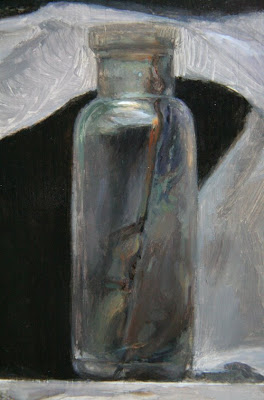
I've received an "I love your blog" award from artist and teacher
Pat Aube Gray, I'm honored! As a recipient I must list 7 things I love. My husband, my family and my 3 orange tabbies are of course at the top of my list, but I'll expand a bit for interest:
1. I love how seriously museum guards take their job. All over the world I have put my nose close to see the brushstrokes of paintings, and all over the world I have never gotten away with it for more than 3 seconds. Museum guards have a pride in their work and a diligence we should all hope to emulate in every aspect of our lives.
2. I love when the sky is dark with low clouds but the sun peeks through from a late angle and makes the world turn gold. The dark purple sky and shining gold earth gives me a feeling of terrible joy, only ever lasting a few moments.
3. I love my art studio. It is set up with everything I need to be productive and un-distracted. It is quiet except for the sounds I play in it, it is easy to heat with my space heater, it has a skylight the opens for fresh air and an installed fan to blow out fumes for the rare times I use turpentine. It has a stool the perfect height so I can either stand or sit to keep my head in the perfect spot to see my subject. And it has the most wonderful, cool lovely light, constant all day except for when the fog rolls in.
4. I love the sound of lawn mowers and what we used to call "heat bugs" (cicadas). They signal summer to me, at least the summer in the North East of the US.
5. I love San Francisco. Every time of day here has beautiful light shining on beautiful architecture and any quick walk or drive always shows me a scene so beautiful I want to paint it.
6. I love koi fish. Ever since I was a kid they have fascinated me and my dream is to have a koi pond someday. I once built an indoor fish pond in one of my apartments, it had a pump and a small waterfall and was made of bricks and sat on the floor. It had goldfish in it, and I learned that goldfish were bred to be admired from above, not from the side as they are seen in a glass fishtank.
7. I love staying up late to talk around a table with old friends, especially with wine. It's probably my favorite thing to do.
Now I need to list 7 art blogs I love to pass along the award. These are blogs I enjoy every time something new pops up. They might not post every day, but every post is a gem.
Daily RoutinesNot really an art blog, but related - this site chronicles the daily schedules and habits of famous artists, writers and philosophers of all stripes. I find it inspiring some days, daunting other times, but always interesting.
A Year in ArtJason Brockert shares both the practical nitty-gritty of being a working artist and also his philosophies and musings in a year of weekly essays, inspiring and entertaining always.
Nathan FowkesI am always stunned by how Nathan can show everything from the planes of the head to the play of light on a landscape with just a few strokes. And he teaches!
Life Spatula"Spatula" is an art school refugee like me, and her quests to continue artmaking and continue her art education are inspiring, and as an added bonus her witty writing just cracks me up. She's about to join an atelier this year (I think where Nathan teaches even?), so it will be such fun to watch her progress (she better keep posting!).
Scott Conary and
Shawn KennyI almost didn't list these two because I am friends with both from our art school days at RISD. But they are both amazing, juicy painters and I'd love to share both their work if you don't know of them already.
That's only 6! But I follow a lot of blogs and I admire them all, you can see them all in the right column here.

 Had fun spending most the day on the front edge of the shelf, all the chipped paint and knots and scratches were so satisfying to paint, and so much faster than the wax paper. Now everything is done except for a couple more sessions on the wax paper.
Had fun spending most the day on the front edge of the shelf, all the chipped paint and knots and scratches were so satisfying to paint, and so much faster than the wax paper. Now everything is done except for a couple more sessions on the wax paper.

























